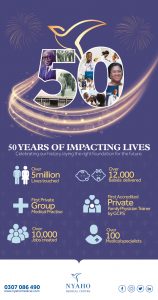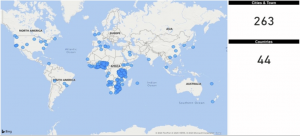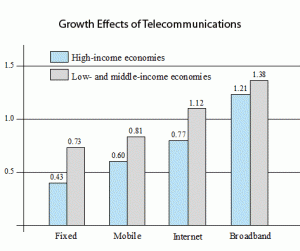In almost every country connected to an international fibre connection in Africa in 2010, the speed of the connection increased and prices fell. Our own personal experiences from travelling extensively across the continent confirm what we know from the data that comes to us from other sources. Ookla’s latest Net Index statistics which shows which ISPs in South Africa give the best broadband speeds gives the clearest sense of this shift. According to the results from 184,442 Speedtest.net tests between 14 November 2010 and 13 December 2010, Cell C is the best service provider with an average download speed of 4.62 Mbps. Web Africa is second with 2.81 Mbps and Telkom third with 2.54 Mbps. Mybroadband.co.za has published a table with the top ISPs. To access it click here 2-4 mbps download speeds? Who would have believed that five years ago?
Almost as interestingly, Main One has been running a test site offering free, high capacity bandwidth in the Palms Shopping Mall in Lagos’ Lekki district which is operational until 9 January. According to a blog by Olunyi Ajao who went to try it:” I was more excited with the potential speed, than it being a freebie. You see, Main One is a submarine cable system that carries gigabytes of data from Europe to West Africa and so, I expected their connectivity (without going through MTN or another ISPs that use them) to be an extreme experience. In plain English, Main One is an ISP’s ISP. So, I went to the mall with very high expectations”.
“The speed met my expectations. I commenced downloading all the stuff I had always differed…. I was able to download content at a steady speed of 2 MB/s (with two other downloads in progress) on Main One’s wi-fi but the maximum (unsteady) speed I can get downloading via MTN’s 3.5G service is about 0.48 MB/s”.
“Just to be triple sure, I initiated a video call to a friend in Malaysia via Skype. Though we could not talk much due to the noise around me, he confirmed the video was very smooth. Youtube videos (including HD versions) streamed smoothly for me today”.
His main irritation?:”My Blackberry and (later) my Nokia 5800 XM could not detect MainOne’s wi-fi signal. Consequently, I could not experience the broadband on my smartphones. I was initially able to download some a podcast on the 5800 XM but that started failing after I upgraded the Operating System on the smartphone.The connection went off every hour or there about, and I had to always reconnect via my browser. I reckon this was their lame method of enforcing their “2 hour limit”.
Nevertheless, he concluded “the speed was worth the trouble”. And his not too startling conclusion?:”The ISPs necessarily need to invest in better last mile technologies or improve their existing networks so consumers can enjoy the real broadband that is possible via MainOne. I know of Mobitel‘s 4G and Swift‘s WiMax but both have limited coverage”. For the full blog click here
So now the moment has arrived for broadband Internet in Africa, all operators need to get focused on selling it to individual consumers. For if they don’t, there will be an awful lot of unsold international bandwidth on their balance sheets for years to come.
Currently, there are three broad types of operators who are in this market: firstly, Africa’s traditional independent ISPs who have lived largely on corporate subscribers and a small number of wealthy individual; the mobile operators who have come in and expanded the market with mobile Internet; and alternative insurgent challengers like Wananchi with its Zuku brand. The African consumer broadband market is still just being born so no-one has yet got a full grip on the market. Consumers are fickle and go where price and bandwidth seem most advantageous.
In the interests of creating a strong and vibrant African broadband consumer market, here are our seven tips on making this market work:
1. Be honest and straightforward
When it’s not price wars (which are easy to understand), Africa’s operators seem to offer a baffling array of different tactical marketing offers. Using the techniques pioneered in selling voice, mobile operators offer their customers short-term, tactical financial advantage. The result? Customers game the system about as thoroughly as consumers anywhere in the world. If it’s cheaper at 3pm in the morning, they’ll be awake and using it. Privately, most operators will admit that this is no way to change their market share but seem obsessed by the monthly percentage changes tactical marketing brings.
Operators have also sought to “slice-and-dice” the sale of their bandwidth capacity in so many different ways that it’s hard to know what you’re buying. How many Internet consumers know what a 4 Mb download capacity means? How do you know what you’re getting during a hour’s worth of Internet? What does unlimited subject to a “fair use” clause actually mean? Cyber-café and WiFi hot-spot operators continue to dilute bandwidth even though a great deal more is available at cheaper prices: old habits die hard. Take your profit while you can seems to be the unspoken mantra.
The operator that is consistently honest and straightforward has every chance of winning this game. If you say to your customers, you have two choices, price and bandwidth speed: which do you want? For those budget customers, set a much higher provisioning (2 mbps as a minimum) but clearly indicate that this speed may be considerably less during busy periods. For those who need higher speeds, charge more and give them a demonstrably better service (perhaps 8 mbps as a minimum). Set up bandwidth speed comparison tests internally first and then allow your customers to use them. Use the information gathered to drive out bottlenecks at the national and local level.
For the alternative insurgent challenger, there’s the perfect opportunity to arrive as “Honest John” amongst those who seem to speak less than straightforwardly. The challenger can be clear about what it’s offering and that it’s seeking to get all of its customers the best deal possible.
2. Service – Making things work
The mass broadband market in Africa needs to work on a “plug-and-play” basis. The household consumer needs to be able to open the box, plug in a limited number of cables and then follow the on-screen prompts to get things working. Household broadband needs to be cheap, well-supported and reliable equipment so that CPE costs are kept as low as possible.
When things do go wrong, companies need to have service back-up that can deal quickly and efficiently with complaints. Companies need to analyse where breakdowns and other complaints occur and figure out ways of dealing with them as quickly as possible. They need to encourage user forums where customers can compare notes and find ways of overcoming some of the issues themselves.
Two contradictory things are in play: firstly, in order to deliver the best broadband service at the cheapest price, it has to “get-up-and-go” at the cheapest possibly cost; secondly, consumers will become more demanding as speeds and performance increase. On the second, the absence of bandwidth suddenly seems like a “life-and-death” issue, not some minor irritation to be taken with the usual African patience when almost anything doesn’t work. So how to resolve these contradictory pressures? Educate users to pay for service contracts. At the bottom end, the amount charged will be very small but at the top end it will be much larger and contain time-based response clauses. Within this framework, be absolutely rigorous about providing friendly and response service.
3. Branding, character and use
When they took off, African mobile operators were selling aspiration. If you had a phone, you were somebody. Back then, it was all new but now there’s not an African city that doesn’t have billboards showing desirable young models smirking their way through conversations on mobile phones. With the introduction of mobile Internet, these same aspirational images have been simply transferred over. Can you tell the difference between the images used? OK, so the colours and the name are different but what else?
Africa’s broadband Internet brands desperately need some “character”, something that will mark them out and make their customers smile and remember them. They need to be able to convey a different version of the aspiration message. There won’t be necessarily the same level of Internet users so the aspiration message has to be more finely honed.
All the soft, aspirational branding constructs have to translate into “uses”. 99% of potential African broadband customers will not care about the technical attributes of the service, only what it can do for them. The young professional will want to put his social life together on Facebook. The parent will want to know that he or she can get education materials that will help their children in school. Grandmas will want to know how to access family photos on Flikr and use Skype to talk to their children. The taxi driver will want access to maps showing street locations, and so on. Too little broadband marketing translates into both selling these uses and identifying new uses to sell.
4. Encouraging maximum use by offering maximum capacity
The African operator that thinks it’s really smart starts by offering a broadband service at the highest price it can get away with and then slowly cascades the price down to a much level. The problem with this approach is that it fails to grasp that the overall market objective must be to create the largest possible “critical mass” of Internet users as quickly as possible.
Unlike voice, where everyone wants to have access, selling broadband Internet is a much harder sell. It relies on getting the mass of current users (the young, educated) to persuade others (the old, educated; staff like child-minders and drivers) to use it as a primary means of communication.
The strongest way to promote the largest “critical mass” is not by dealing it out in “penny packets” but by offering the maximum available capacity at prices that will encourage young and old to do the kind of things on the Internet that people do the world over: things like social media (Facebook, Facebook and Facebook), Twitter and You Tube are giving some idea of where things can go. If there were 1.7 million Nigerian Facebook users in August 2010, imagine how many more there will be in a year’s time.
5. Expanding the potential market
SMS is really just e-mail in budget clothes, the only difference is the character count and the ease of tee-ing up the browser. SMS-to-e-mail workarounds from companies like ForgetMeNot Africa show the potential for transition to full e-mail. And those that currently use SMS with some facility are all potentially on an upward escalator to a wider range of Internet services.
If you imagine the current handset market as a pyramid, the broad base of the pyramid is made up of extremely basic handsets with very little functionality. At the top of the pyramid is a tiny sharp point representing smartphones and the next band down is feature-rich phones. In most markets, these will be barely 5% of the overall market.
To expand the potential market, you need to expand the number of devices that can handle interesting Internet applications. You need to be offering ever-cheaper smartphones with the prize going to the first to offer one for US$50. You need to offer even cheaper feature-rich phones (with a i-Phone-style interface from someone like Snaptu) to the less well-off at below this price point. In this way, the existing basic phones in the market will shrink and the number of customers with Internet access will increase.
6. Building the device pyramid
The mobile is Africa’s tech device of choice and the one that reaches the maximum number of customers. But building an African broadband market requires operators to understand another pyramid.
This second pyramid is about all the tech devices an African broadband consumer might own. The broad base of this pyramid is composed of feature-rich phones, followed further up by smart-phones. Then there are net-books, followed by tablets (like iPad) and at the top of the pyramid lap-tops and PCs.
The challenge with this device ownership pyramid is the same as for the handset pyramid. Mobile phones that can access the Internet are a great thing but they have their limitations. Therefore how do you get all those people who might have access to a PC at work and/or have a feature rich phone to get some sort of wider PC usability? (The main barrier to greater use is size and use of keyboard functions but there are other issues.) Somewhere around the netbook/tablet area is a device that long-term may cost between US$75-100 that will broaden this part of the pyramid and give PC-like abilities to a much wider number of broadband users.
For the ambition must be to create a world in which there is the ability to do things using broadband almost wherever you are: the bar, the home, the hotel and the school.
7. Spreading everyday usage
The lesson of the success of Facebook is obvious in hindsight. The average African professional organizing his or her social life on a Friday afternoon is the “human equivalent of Facebook”. So the insight is really a very obvious one for operators. They need to introduce apps and services that drive everyday use. These might come from elsewhere but in time there will be local variants. In places like India and Brazil, the local variants stamped out their own ground by not being in English. Watch for local variants and see whether they can be marketed successfully to create new, local social media.
Think about the insights from something like M-Pesa, again so clear in hindsight but not when they were struggling to gain traction. It took something that was a major barrier (carrying and pay most things in cash) and challenged engrained habits. So look at other potential areas. What about finding your way round Africa’s cities? How many times have I witnessed the giving of directions that are of the “go past the third flower seller on the right” variety? Of course, there’s Google but how many people will use it? So somewhere between the “human Google” (phoning a friend or fellow taxi driver) and Google sits a much simpler app to help people find where they’re going.
Operators need to keep coming up with ways to weave the Internet into everyday use so that it becomes as natural as….well, picking up your mobile to make a call.
For more insights on the new Internet market, go to Balancing Act’s Web TV channel:click here
Clips include:
* Jessica Verrilli on Twitter’s African strategy.
* Sean d’Arcy, Opera Software on the use of its mobile browser in Africa.
* Reg Sawrt, Fundamo on M-Money Services
* Herman Heunis on social networking with MXit
* Jeremy George, COO, ForgetMeNot Africa on its SMS to e-mail service.
There are 49 clips in both English and French that contain news and information that does not appear in our e-letter or on our web site.





